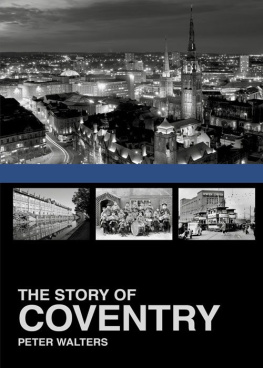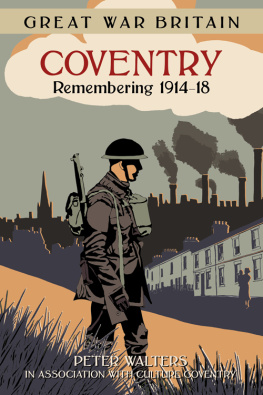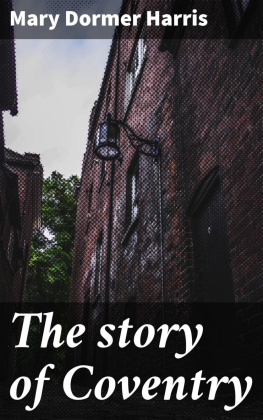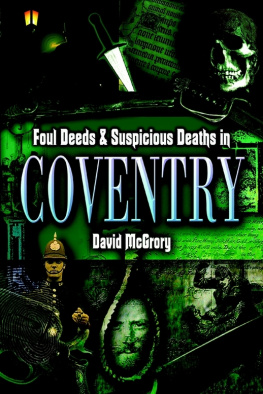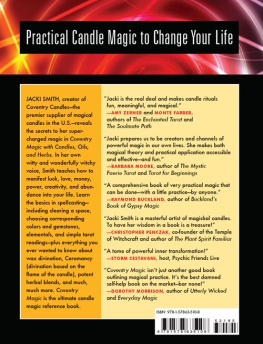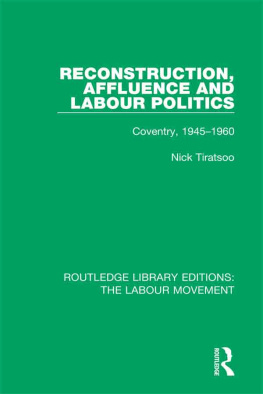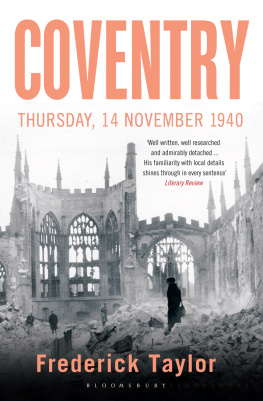CONTENTS
I owe a huge debt of gratitude to all those who have written about Coventrys history, ancient and modern.
More particularly, I want to thank the following for their help in bringing this project to life George Demidowicz, Iain Soden, David Fry, Martin Roberts, Christine Adams, Michael Hinman, Mark Radford, Chris Patrick, Marcus Lynch, Abigail Rhodes, Steve Bagley, Chris Ross, Andrew Paterson, Richard Briggs, Alun Thorne and David McGrory.
I am also indebted to The History Press for images from their own collection.
T here was a time when Coventry enjoyed a spotlight all of its own on the national stage. One of Englands biggest and wealthiest cities, it had hosted more than one parliament and was effectively the seat of royal government for more than a year. Its celebrated cycle of mystery plays attracted crowds from counties around, while its equally famous city wall kept Coventrians safe when others suffered in troubled times.
Coventrys golden age was over long before Henry VIIIs attack on the monasteries tore the heart out of the city, but the shine from that dimming spotlight lingered on.
England remembered the tale of saintly Godiva and the citys place in myth as birthplace of the legendary St George, patron saint and dragon-slayer. Shakespeare sprinkled the citys name through more than one of his plays, and true as Coventry blue, first coined to describe a dye that never ran, entered the language as a colourful way of admiring constancy. At Christmas people sang the Coventry Carol, a haunting refrain to loss, set in a biblical frame. At New Year, children were given Coventry god cakes as a special blessing from their godparents. They played card games like Peeping Tom or Moll of Coventry and in summer they picked the flowers of Coventry Bells, the popular name for the campanula.
Coventry gradually became a byword for quaint, a place of hallowed customs celebrated beneath the spires and gables of past glories as the world hammered away towards industrial revolution. In an age of machines it was still lost in a midsummer dream of crafts and guilds, until a farm boy from Sussex added the delicate skills of making bicycles to those other intricate crafts of watches and ribbons. In the dying years of the nineteenth century, his legacy spawned the first factory in Britain set up to make the motor car, a revolution in personal transport that changed the way we all lived.
Faced with trying to make this new industry fit into an old way of doing things and a medieval street pattern, Coventry became the only city in Britain to jump straight from the late Middle Ages into the twentieth century. Over the decades to come it was to reflect all the themes of the new century rapid industrialisation, mass immigration, boom and slump, even total war. What emerged in 1945 was a different place, a city of the working man, by turns inventive and listless, that had not quite caught up with itself. But as one of the engineering dynamos of Britain it had a place back on the national stage.
Its pioneering Festival of Britain architecture, so widely admired in the post-war years, has managed to overshadow Coventrys remaining heritage in wood and stone and somehow erase the collective memories of the place, stretching back almost a millennium. This is the story of that 1,000 years, full of colour and incident but sadly little known at a time when the national spotlight has again moved away. For all that, it is a story worth telling.
I n August of 1793, The Gentlemans Magazine, in its monthly digest of news from the provinces, reported an event of no little historical curiosity from Coventry.
Its correspondent Explorator announced that he had two pots containing nearly 2,000 Roman coins, recently unearthed on the Bullester Field Farm in the neighbouring parish of Foleshill. And he went on to describe an earlier discovery, right in the heart of the old town: In the last summer the street in Coventry called Broadgate was opened to a depth of five or six feet when a regular pavement was discovered, and upon that pavement a coin of Nero.
He added that it all gave further strength to his theory that a Roman road, linking the known Roman centres of Mancetter and Warwick, ran straight through where Coventry now stood. But could it also be evidence of a long-lost Roman settlement, from which the modern town of weaving and clock-making had sprung?
It appears not. More than 200 years later there is still no positive evidence of Roman occupation in what was to become Coventry. The pavement those eighteenth-century diggers discovered was almost certainly a floor of medieval origin and despite a string of finds by archaeologists, some made very recently indeed, proof that the Romans set up some kind of settlement in Coventry is still as frustratingly difficult to pin down as it ever was.
In some senses, this might seem surprising. In an area very close to the intersection of two major Roman roads with Watling Street (now the A5) only nine miles away and the Fosse Way (A46) just six we might expect there to be a settlement in such a well-watered and well-wooded area, where tradition suggests there had been an ancient trackway over the River Sherbourne, dating back into prehistoric times.
Theres evidence nearby of occupation before the Romans arrived. A substantial settlement of fourteen Iron Age roundhouses was found on the University of Warwick campus, on the southern edge of the city, during work to lay a new university running track in 2002. The roundhouses probably dated from the third century BC .
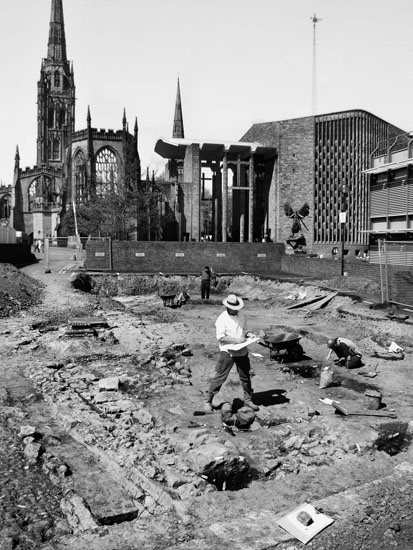
Archaeologists working in Coventry city centre in 2006 found a Roman ditch. (Coventry City Council)
What are believed to be boundary ditches from Romano-British farmsteads emerged from two further modern development sites to the east, during construction of the citys North-South Road (1987) and a new cinema site on the Cross Point business park (1991). As recently as 2006, archaeologists working on the Coventry University site off Priory Street in the city centre came across a ditch and scattered finds that might well have come from another farmstead.
However, the first-century Lunt Fort at Baginton, and the civilian settlement that grew up around it, are the only significant Roman remains to have been discovered in the immediate vicinity of Coventry. From the fort ramparts, reconstructed in the early 1970s, the modern city centre can be seen to the north, some four miles off.
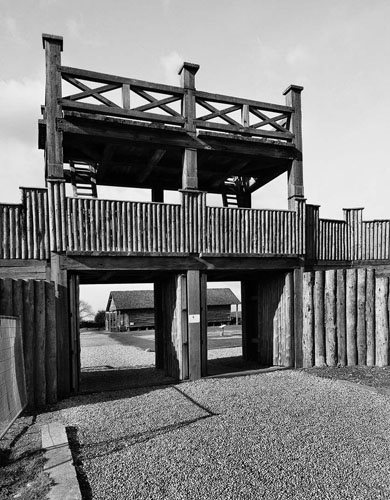
The gateway of the Lunt Fort, reconstructed in the 1970s. (CV One/Coventry City Council)
First evidence of Roman occupation at Baginton began to emerge in the early 1930s, when extensive gravel-working around the edges of the village turned up large quantities of pottery, dating from the first to the third century, and other artefacts that suggested a military occupation there too.
Excavations in the summer of 1960 made the first discoveries of what turned out to be a sequence of military camps. The earliest of these are dated AD 6061, when the Roman governor of Britain, Gaius Suetonius Paulinus, brought the rebellious Boudica, Queen of the Iceni, to her final reckoning.
That bloody and decisive engagement may well have taken place somewhere near Mancetter, more than twenty miles away at the northern edge of Warwickshire. It is believed that The Lunt was constructed by a unit of auxiliaries to deal with the many horses captured from the rebels by the victorious Roman army. Certainly the Gyrus, or horse-training corral, is its most important feature. No other quite like it has been found in the whole of the Roman Empire.

